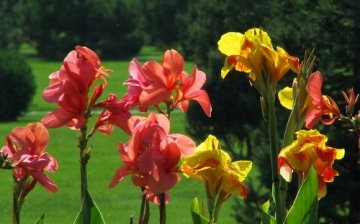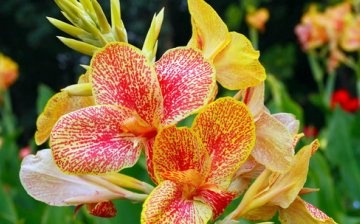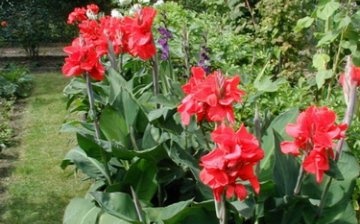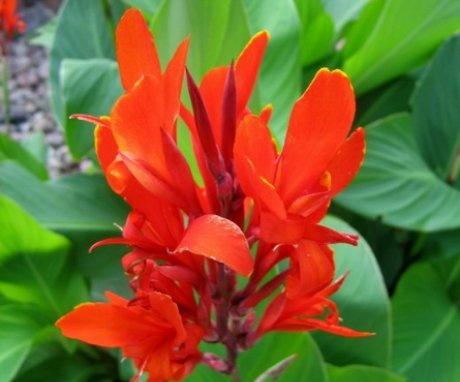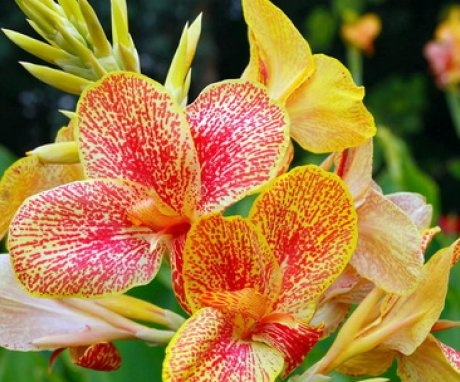Cannes flowers in the photo
Unusual-looking flowers, similar to exotic gladioli, have an equally striking name, consonant with the name of the world famous city - Cannes. The homeland of this perennial herb is the tropics of South America, Asia and China. Since the flowers were brought to Russia, and this happened during the time of Peter I, many new domestic varieties have been bred and a rich collection has been collected. The Cannes Breeding Center is located in Yalta, in the Nikitsky Botanical Garden.
Content:
- Cannes leaves
- Flowers
- Flowering duration
- Reproduction
- Growing conditions
- Plant care in winter
- Diseases and pests
- Decorativeness of the plant
Cannes leaves
Plant canna quite powerful, with high fleshy stems, depending on the variety, having different heights from 0.5 to 3 m.The beauty of the canna is not only in its flowers, but also in the leaves, large, oval in shape, up to 25 cm wide. - dense, like glossy. Water flows from them without lingering. The leaves are often colored heterogeneously, in saturated bronze-red, gray-gray or green tones, they can have longitudinal stripes, sometimes there is a border around the edges.
In an immature state, the leaves are rolled up into a tube that looks like a reed, which in Greek is "canna".
Flowers
Canna flowers are combined into loose clusters up to 35 cm high. The buds open gradually, starting from the lowest, forming cream, yellow, dark purple, red, orange inflorescences on a straight arrow. The flower is asymmetrical, it can have a speckled or striped pattern. One bush is usually decorated with 3-4 tassels at the same time. Cannes is odorless.
Flowering duration
Cannes vary in flowering time. In early varieties, buds begin to bloom in the second half of June, in later varieties - from mid-July. But all varieties are distinguished by the duration of flowering, which lasts until the very frost. To preserve the beauty of plants, faded parts must be removed in time.
Reproduction
Cannes have large fleshy rhizomes in the form tubers, which are most often used for flower propagation. In early spring, the rhizome is divided into as many parts as it contains buds, disinfected with a manganese solution and planted in cups with a mixture of humus, compost and sand. Once every 10 days, it is recommended to water the growing plants with a solution of potassium permanganate.
Another breeding method that can be used no later than February is from seeds. They are pre-soaked and sown in a warm place, at a temperature of about +22 degrees. Plants can be transferred to open ground only at stable positive temperatures, because frosts are harmful to flowers. Some of the cannes grown from seeds can bloom only by the next summer.
Growing conditions
In the climate of the middle lane, gardeners begin planting cannes not earlier than the May holidays. The soil must be well prepared before planting the plants. It is fertilized with humus and manure to a depth of 0.8 m.
Seedlings are planted in pre-dug and well-moistened holes. The distance between the cannes should be at least 0.5 m.
Cannes are unpretentious in cultivation. They love sunny, open places, tolerate hot weather well, but need abundant watering. Of the soil, they prefer airy, fertile, so the land must be periodically loosened and weeded from weeds.
Over the summer, flowers need to be fertilized with mineral fertilizers at least 2 times.The soil is preliminarily watered abundantly, and then nitrogen-phosphorus-potassium granular fertilizers are evenly scattered.
Plant care in winter
Heat-loving cannes do not tolerate wintering in the open field. With the onset of autumn they are dug up, cut off stems and leaves at a distance of 10 cm from the root, the rhizome is dried and stored in a frost-free room with a temperature of about +8 degrees.
As another wintering method at the end of August, plants can be transplanted into boxes and moved indoors. If the cannes do not forget to water regularly, then they will very easily transfer the transplant. In order for the flowers to have enough light, containers are placed closer to the windows.
In winter, cannes do not need abundant watering, it is enough to reduce it to once every 2 weeks. With the arrival of spring, flowers need to be planted.
Diseases and pests
The advantages of cannes include their high resistance to disease. But with excessive moisture, the likelihood of bacterial diseases increases. Occasionally, flowers can be affected by gray rot or rust fungus, in which case diseased plants should be removed from the site as soon as possible.
Insecticides will help get rid of butterfly caterpillars. When yellow leaves appear, you must use a solution of potassium permanganate.
Decorativeness of the plant
Due to their high decorative properties and duration of flowering, cannes are widely used for landscaping alleys, central squares and streets. In flower beds, cannes usually occupy an honorable centerpiece. Gardeners create spectacular flower gardens from cannes alone, advantageously playing on the variety of heights and shades of inflorescences.
Canna is not only an ornamental plant. In its homeland, it is known as edible; its tubers contain a large amount of starch. Residents of South America still use baked rhizomes for food and for the production of starch.



